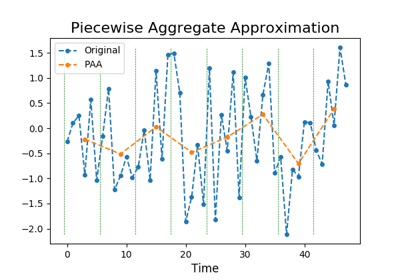pyts.approximation.PiecewiseAggregateApproximation¶
-
class
pyts.approximation.PiecewiseAggregateApproximation(window_size=1, output_size=None, overlapping=True)[source]¶ Piecewise Aggregate Approximation.
Parameters: - window_size : int, float or None (default = 1)
Length of the sliding window. If float, it represents a percentage of the size of each time series and must be between 0 and 1.
- output_size : int, float or None (default = None)
Size of the returned time series. If float, it represents a percentage of the size of each time series and must be between 0. and 1. Ignored if
window_sizeis not None. It can’t be None ifwindow_sizeis None. If you want to useoutput_sizeoverwindow_size, you must setwindow_size=None.- overlapping : bool (default = True)
When
window_size=None,output_sizeis used to derive the window size; the window size is fixed ifoverlapping=Trueand may vary ifoverlapping=False. Ignored ifwindow_sizeis specified.
References
[R5f91eb1fc1e8-1] E. Keogh, K. Chakrabarti, M. Pazzani, and S. Mehrotra, “Dimensionality reduction for fast similarity search in large time series databases”. Knowledge and information Systems, 3(3), 263-286 (2001). Examples
>>> from pyts.approximation import PiecewiseAggregateApproximation >>> X = [[0, 4, 2, 1, 7, 6, 3, 5], ... [2, 5, 4, 5, 3, 4, 2, 3]] >>> transformer = PiecewiseAggregateApproximation(window_size=2) >>> transformer.transform(X) array([[2. , 1.5, 6.5, 4. ], [3.5, 4.5, 3.5, 2.5]])
Methods
__init__(self[, window_size, output_size, …])Initialize self. fit(self[, X, y])Pass. fit_transform(self, X[, y])Fit to data, then transform it. get_params(self[, deep])Get parameters for this estimator. set_params(self, \*\*params)Set the parameters of this estimator. transform(self, X)Reduce the dimensionality of each time series. -
__init__(self, window_size=1, output_size=None, overlapping=True)[source]¶ Initialize self. See help(type(self)) for accurate signature.
-
fit_transform(self, X, y=None, **fit_params)¶ Fit to data, then transform it.
Fits transformer to X and y with optional parameters fit_params and returns a transformed version of X.
Parameters: - X : numpy array of shape [n_samples, n_features]
Training set.
- y : numpy array of shape [n_samples]
Target values.
- **fit_params : dict
Additional fit parameters.
Returns: - X_new : numpy array of shape [n_samples, n_features_new]
Transformed array.
-
get_params(self, deep=True)¶ Get parameters for this estimator.
Parameters: - deep : bool, default=True
If True, will return the parameters for this estimator and contained subobjects that are estimators.
Returns: - params : mapping of string to any
Parameter names mapped to their values.
-
set_params(self, **params)¶ Set the parameters of this estimator.
The method works on simple estimators as well as on nested objects (such as pipelines). The latter have parameters of the form
<component>__<parameter>so that it’s possible to update each component of a nested object.Parameters: - **params : dict
Estimator parameters.
Returns: - self : object
Estimator instance.


